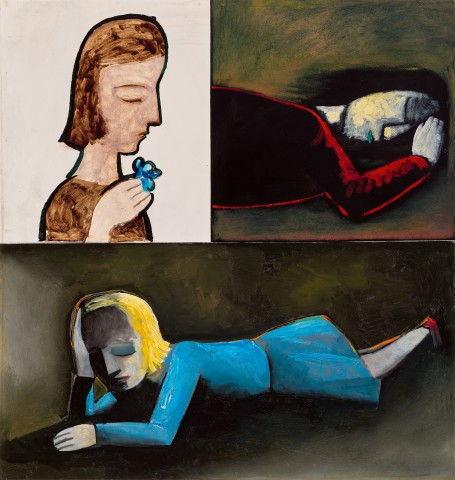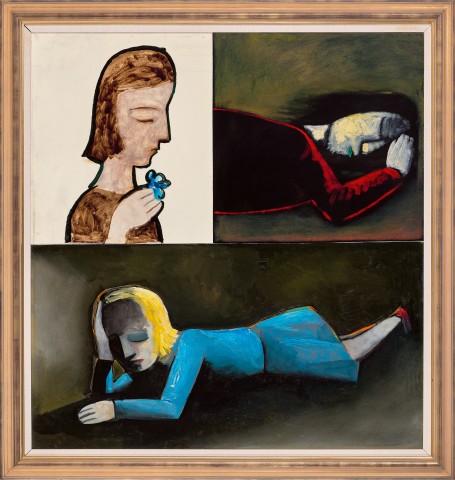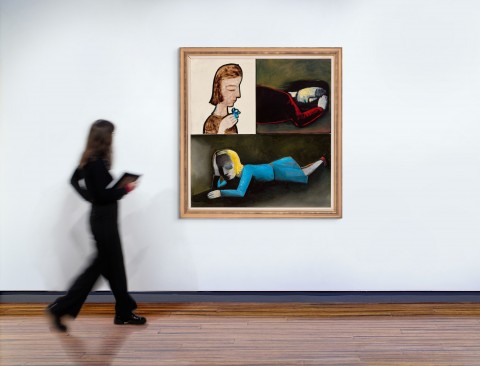SUITE, 1961
CHARLES BLACKMAN
oil on composition board
129.0 x 122.0 cm
signed and dated upper right: BLACKMAN 61
The Matthiesen Gallery, London
Private collection, Sydney
With Mason Gray, Sydney, June 1988
Private collection, Melbourne
Paintings and Drawings: Charles Blackman, The Matthiesen Gallery, London, UK, 3 – 25 November 1961, cat. 12 (illus. in exhibition catalogue)
‘…Part of their essential character springs from the interpretation, marvellously developed and sustained, between the tenderness and grace of the personages contained in the paintings and the fiercely implacably controlled means taken to give these personages life and eloquence within the terms of painting itself…’1
At the time of unveiling his seminal solo show at Matthiesen Gallery in London in November 1961 (in which the present Suite, 1961 was exhibited), Charles Blackman’s star was in the ascendent. In 1958, one of his Alice paintings had been acquired by the Musée d’Art Moderne in Paris (a remarkable feat for any Australian artist), and in June 1960, his solo exhibition at the Johnstone Gallery had completely sold out, realising approximately £4,500 pounds and enabling the Blackmans to buy a house in St Lucia, Queensland. Two months later he was awarded the prestigious Helena Rubinstein Travelling Art Scholarship for his celebrated Suites I – IV (now housed in the collections of the state galleries of New South Wales, Queensland and Western Australia), and by the following February, he and his family had relocated to London where they would remain for the next five years. In June 1961, three of his paintings were featured in the groundbreaking Recent Australian Painting exhibition at the Whitechapel Art Gallery in London, alongside major works by Boyd, Nolan, Tucker and Whiteley, and later that year, he was selected, together with Whiteley and Lawrence Daws, to represent Australia at the progressive Biennale des Jeunes organised by the Musée d’Art Moderne, Paris.
An impressive achievement both in scale and conceptual breadth, Suite comprises one of a select few works created during this pivotal period in Blackman’s oeuvre when, stimulated by the dynamic European art scene, he was at the height of his artistic powers and critical success. As one London newspaper critic observed of his representation at the Whitechapel show, ‘The most moving – and the discovery of the exhibition – are the three remarkable paintings by Charles Blackman… It is fanciful to see in this painting not only a new and original talent but a sign that Australian painting is at last moving away from its obsession with the outback…’2 Meanwhile, English art critic Bryan Robertson, an early champion of the young Antipodean’s work, was so impressed that he offered to arrange the subsequent solo exhibition for Blackman at the Matthiesen Gallery, writing in the Preface to that catalogue: ‘These are some of the strongest, most urgent and forceful paintings by a young artist that I have seen in the past ten years.’3
Possibly with the present work in mind, Robertson continued: ‘…Perhaps the dense blacks refer to the discrepancy between innocence and experience, making a further parallel with the tension between the idea and its projection, its shape and surface. We are given a curious impression, often of a double image, positive and negative, as well as of the space between people… The formal roots of Blackman’s paintings extend beyond the Renaissance to Byzantium. He has made icons from the commonplace material of domestic life. The fragile gestures and spontaneous movements among people in the streets around us are caught and made eloquent...’4 Separated into three voyeuristic vignettes, the present Suite is populated entirely by female forms in various poses and guises – one silhouetted in bright light, and the other two reposing figures surrounded by vaguely threatening shadows. Tough yet tender, firm of outline but fragile of psyche, indeed the work typifies brilliantly the formal, iconographic and emotional ambiguity of these early London pictures which brought Blackman such acclaim. Exuding both a sense of desolate loneliness and curious serenity, Blackman’s enigmatic dreamworld thus offers a rich matrix for the viewer’s imagination – for what Ray Matthew called ‘introspection distanced… by identification with others.’5
1. Robertson, B., ‘Preface’, Charles Blackman: Paintings and Drawings, The Matthiesen Gallery, London, 1961, n.p.
2. Pringle, J. D., ‘The Australian Painters’, Observer, London, 4 June 1961, n.p.
3. Robertson, op. cit.
4. ibid.
5. Mathew, R., ‘London’s Blackman’, Art and Australia, Sydney, vol. 3, no. 4, March 1966, p. 283
VERONICA ANGELATOS


